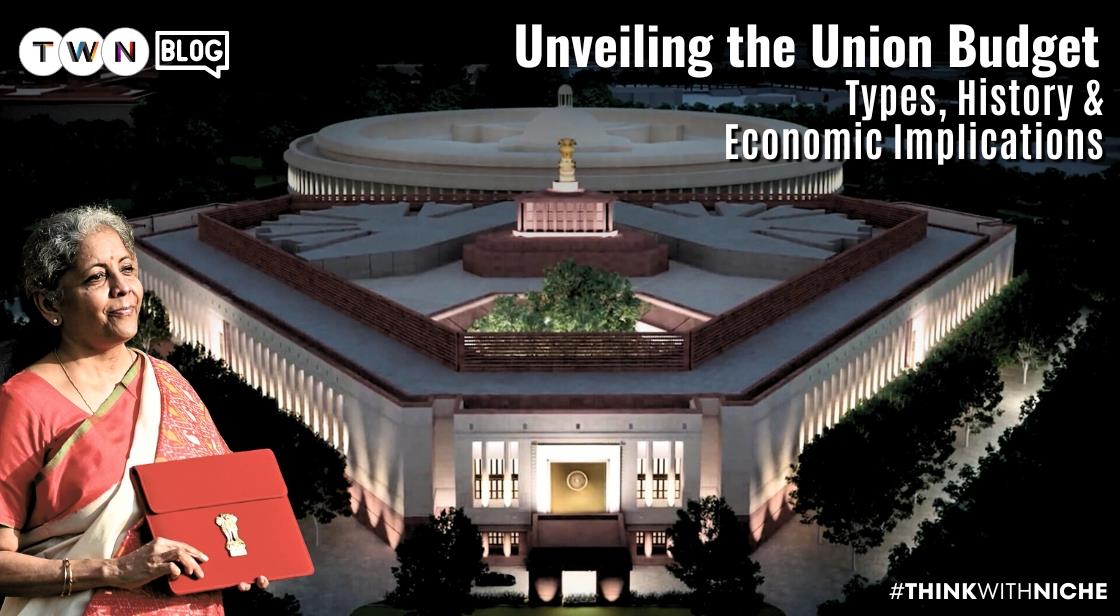Unveiling the Union Budget: Types, History, and Economic Implications

Blog Post
If you have ever seen one of your parents who is responsible for managing all matters related to finances, you might have noticed that all their economic decisions and activities are based on their budget. So, here budget is nothing but the sum of all the expenses and income. Every person may have a different budget according to his income and expenditure.
Embarking on an exploration of India's economic cornerstone, this comprehensive blog post unveils the intricacies of the nation's budget – a pivotal document that shapes the financial landscape and steers the course of the economy. From understanding the fundamental types of budgets to delving into historical milestones and impactful changes, we navigate through the historical, procedural, and impactful aspects of India's budgetary framework.
As Finance Minister Nirmala Sitharaman prepares to present the forthcoming budget, we unravel the significance of this annual fiscal ritual. Beyond being a mere statement of income and expenditure, India's budget plays a crucial role in planning, controlling, and propelling the nation's financial affairs.
From the historical significance of the first budget after independence to the contemporary inclusion of green initiatives, we embark on a journey through time, witnessing the evolution of India's financial roadmap.
Moreover, the article provides an in-depth look at the various types of budgets in India – from the Annual Financial Statement (AFS) to gender and green budgets. Understanding the budget's impact on different sectors, its role in shaping economic growth, and its influence on societal fabrics forms a crucial part of this journey.
With an eye on the future, the discussion culminates in reflections on the potential innovations and changes needed for India's budget to adapt to evolving challenges and opportunities.
Beyond being a static document, India's budget emerges as a dynamic compass guiding the nation's economic journey. By grasping its multifaceted impact, we empower ourselves to actively engage in constructive dialogue, ensuring that the budget serves the well-being of every citizen and weaves a prosperous future for all.
Keeping in mind the importance of Budget, today in this blogpost we will throw light on some common but important facts related to the budget.
So let's start our journey in which we will understand the definition of budget, its types and its possible effects on the country's economy.
India's Annual Budget: A Comprehensive Guide to Types and Processes
What is the budget?
The document in which the details of income and expenditure of the government are collected is called budget. Actually, the budget contains the account of income and expenditure of the central government for 3 years. What was the income and expenditure of the government last year, what is the current amount and what is the expected income and expenditure next year.
Budget is an extremely important part of the economy of any country as it helps in planning and controlling its financial affairs.
More money than the amount determined in the budget cannot be spent. If more money is required, permission has to be taken again from Parliament. Budget is a statement. Which generally forecasts revenue and expenditure for a period of one year.
The budget 2024 will be presented by Finance Minister Nirmala Sitharaman on 1 February 2024 and this will be the first time that a woman Finance Minister will present the sixth consecutive Union Budget in Parliament.
Definition of Budget
The origin of the word "budget" is unclear, but it is thought to come from the French word "bougette," which means "little purse." The word first appeared in English in the 17th century and has been in common use ever since.
Know what is Article 112?
Article 112 of the Indian Constitution deals with budget making. Article 112 defines the budget as the ‘annual financial’.
India's First Budget
India's first budget was presented on November 26, 1947, just three months after the country gained independence from British rule. It was a historic moment, marking the beginning of a new era for India's financial management.
R. K. Shanmukham Chetty, India's first Finance Minister presenting the first budget
The budget was presented by R. K. Shanmukham Chetty, the first Finance Minister of independent India. It was an interim budget, as the government was still in the process of setting up its financial systems.
Earlier the budget papers were printed in Rashtrapati Bhavan only. But after the budget papers were leaked in 1950, they started being printed in the Security Press located in Delhi. Initially the budget was made in English. But from 1955-56, budget documents started being prepared in Hindi also.
Some interesting facts about India's first budget:
- It was presented in English, as Hindi was not yet the official language of the government.
- The budget document was only 18 pages long.
- The budget was printed at the Government of India Press in New Delhi.
- The budget speech was broadcast live on All India Radio.
India's first budget was a significant milestone in the country's history. It laid the foundation for a strong and stable economy, and helped to set India on the path to becoming a global economic power.
Budget and Halwa Ceremony
Understanding the Halwa Ceremony:
The Halwa Ceremony is a significant prelude to the elaborate process of budget preparation, spanning several months. This ceremonial event is more than just tradition; it serves as the official commencement of the printing process for various documents integral to the budget.
Beyond the Ceremony: A Glimpse into the Budget-Making Process
The Halwa Ceremony is merely the tip of the iceberg. The budget-making process is a complex, multi-phased journey:
-
Initial Inputs: Various entities such as ministries, states, and defense forces submit their budget estimates.
-
Internal Negotiations: The Finance Ministry meticulously revises and negotiates these estimates, balancing priorities and resource allocation.
-
Prime Ministerial Approval: Once finalized, the budget proposal receives the Prime Minister's approval before heading to the printing stage.
Change in Budget time
Till the year 2000, according to the English tradition, the budget was presented at 5 pm. This practice was started by Sir Basil Blanket in 1924. The reason behind it was to provide rest to the officials who had to stay awake all night preparing financial accounts.
The NDA government led by Atal Bihari Vajpayee broke this tradition. For the first time in 2000, Yashwant Sinha presented the budget at 11 am.
Change in Budget date
Before 2017, the budget was presented on the last working day of February. In 2017, it began to be offered on the first working day of February.
Inclusion of Railway Budget in General Budget
From the 2017 budget itself, the Central Government has included the Railway Budget in the General Budget. In 1924, on the basis of the recommendations of the Ekvar Committee, the Railway Budget was separated from the General Budget.
What are the types of Indian Budgets?
In India, there are several types of budgets used for different purposes and circumstances. Here are some of the most common:
1. Annual Financial Statement (AFS):
- This is the main budget document, presented by the Finance Minister on February 1st each year.
- It includes details of the government's estimated revenue and expenditure for the coming year, along with proposed tax changes and other fiscal measures.
- The AFS consists of two parts:
- Consolidated Fund: This includes all the taxes and non-tax revenue of the government and the expenditure incurred on various schemes and services.
- Public Account: This covers the receipts and payments related to government borrowings, investments, and public debt management.
2. Interim Budget:
- Presented temporarily when a new government is formed before the first full budget.
- Covers only the remaining part of the current financial year until the full budget is presented.
- Usually does not make major policy changes or introduce new taxes.
3. Vote on Account:
- A temporary authorization granted by Parliament to the government to withdraw funds from the Consolidated Fund to meet essential expenses until the full budget is passed.
- Used when the full budget cannot be presented on time due to various reasons.
4. Supplementary Budget:
- Presented during the course of the financial year if there is a need for additional funds beyond what was originally allocated in the AFS.
- Requires Parliament's approval.
5. Performance Budget:
- Introduced in 2005-06, focuses on the outcomes and outputs of government programs rather than just the financial inputs.
- Measures the efficiency and effectiveness of government spending.
6. Zero-Based Budget:
- Not yet implemented in India but considered in times of fiscal stress.
- Requires each program and expense to be justified from scratch, regardless of previous allocations.
- Aims to eliminate wasteful spending and improve allocation of resources.
7. Gender Budget:
- Focuses on gender equality and women's empowerment by analyzing the impact of government programs on different genders.
- Identifies and addresses gender biases in resource allocation and policy formulation.
8. Green Budget:
- Focuses on environmental sustainability and green initiatives.
- Analyzes the impact of government policies on the environment and identifies opportunities for greener investments.
These are just some of the various types of budgets used in India. The specific type of budget used depends on the circumstances and the government's priorities.
Who prepares the budget?
The preparation of India's budget involves a collaborative effort from various entities, led by the Ministry of Finance under the Department of Economic Affairs (DEA). Here's the breakdown:
1. Department of Economic Affairs (DEA):
- Acts as the nodal agency for budget preparation.
- Forms a budget division responsible for drafting the budget document, gathering data, and analyzing economic trends.
2. Other Ministries and Departments:
- Each ministry and department submits proposals for their respective needs and expenses for the upcoming year.
- These proposals are analyzed by the DEA and adjusted based on available resources and government priorities.
3. Finance Minister:
- Plays a key role in shaping the final budget.
- Makes final decisions on resource allocation, tax measures, and other policy proposals.
- Presents the budget document to Parliament on February 1st.
4. Additional Support:
- The Finance Minister is assisted by a team of advisors, economists, and budget experts from various fields.
- Independent institutions like the Reserve Bank of India (RBI) also provide economic data and analysis that inform the budget process.
Therefore, while the Ministry of Finance takes the lead, the final budget reflects the combined efforts of various stakeholders working towards shaping India's economic policies for the coming year.
Here are some interesting facts about the budget preparation process:
- The preparation starts months before the actual presentation, usually around August-September of the preceding year.
- The process involves several rounds of consultations and meetings between the Finance Ministry, other ministries, and experts.
- The budget document is printed at a secure press under strict secrecy to maintain confidentiality.
How is it decided which ministry will get how much money? How is it decided which ministry will get how much money
Every ministry tries to get maximum funds in the budget. For this, in October-November, the Finance Ministry meets with other ministries and prepares a blueprint as to how much amount will be allocated to which ministry in the budget. For this everyone bargains with the Finance Ministry. This process continues till November across all ministries and departments of the government.
When is the draft budget prepared? When is the Draft Budget prepared
As soon as December arrives, the first draft copy is placed before the Finance Minister. The paper of draft copy is blue in colour.
The budget is presented in two ways
1. Annual Financial Statement -
This statement called Annual Financial Statement is the main budget document, in which the receipts and payments of the government are divided into three parts which are as follows - Consolidated Fund, Contingency Fund, Public Account.
The amounts received by the government from all states as a result of recovery of loans given by the government from borrowings taken by it are shown in the Consolidated Fund. All expenditure of the government is made from the Consolidated Fund and no amount can be spent in this fund unless it is approved by the Legislative Assembly.
Sometimes such occasions may also arise when the government, even before getting the approval of the Legislative Assembly, has to incur some very important expenditure which is not estimated in advance and the expenditure of which is unavoidable from the point of view of public interest and which is possible to be avoided. Don't be.
Apart from the general receipts and expenditure of the government which are related to the Consolidated Fund, some other transactions like transactions in relation to provident funds, employee group insurance scheme, other deposits etc. are also accounted for in the government accounts. The government acts almost as a banker in relation to these transactions. The amount received in this way is shown in the public account.
2 . Demand for Grant
Demand for Grants is the form in which the estimate of expenditure from the Consolidated Fund, in pursuance of Article 113 of the Constitution, is included in the annual financial statement and which requires a vote. This grant is required when the amount authorized by the Parliament through the Appropriation Act for a particular service for the current financial year is found insufficient. This grant is presented and passed by the Parliament before the end of the financial year.
Union Budget: Key Points and Key Facts You Need to Know
First ever Budget
The first budget of India was announced in pre-independence India on April 7, 1860, when James Wilson, a Scottish economist and politician of the East India Company, presented it to the British Crown. After independence, the first budget of India was presented on November 26, 1947 by the then Finance Minister RK Shanmukham Chetty.
Longest Budget speech Iongest Budget speech
Nirmala Sitharaman, India's first woman Finance Minister, holds the record for the longest speech when she delivered the speech for two hours and 42 minutes while presenting the 2020-21 Union Budget on February 1, 2020. With two pages still remaining, he had to cut his speech short. He broke his own record of July 2019 – his first Budget – he spoke for two hours and 17 minutes.
Other notable long Budget Speeches:
Former Prime Minister Manmohan Singh may have been a man of few words, but during his tenure as Finance Minister, he gave the speech with the highest number of words – 18,650 – in 1991.
Finance Minister of the first term of Modi government - Arun Jaitley - comes in second place with a speech of 18,604 words. Jaitley spoke for one hour and 49 minutes.
Shortest Budget speech
The 1977 budget speech, given by Finance Minister Hirubhai Muljibhai Patel, was only 800 words long.
Know who has presented the highest budget?
Former Prime Minister Moraraji Desai holds the record for presenting the highest budget so far. He presented 10 budgets during his tenure as Finance Minister during 1962–69, followed by P.Chidambaram (9 times), Pranab Mukherjee (8 times).
How does the budget affect the economy?
India's Budget: Weaving the Fabric of the Economy
India's annual budget, presented on February 1st, holds immense significance. It's not just a mere accounting of numbers; it's a meticulously crafted narrative, weaving the threads of government spending, taxation, and policy changes to paint a picture of the nation's economic future. But how does this intricate tapestry actually affect the lives of everyday citizens? Let's delve deeper to understand the multifaceted impact of the budget on our economy.
1. Steering the Wheel of Growth:
Investment and Infrastructure:
The budget plays a crucial role in driving infrastructure development through targeted allocations for sectors like roads, railways, and clean energy. This not only creates jobs but also improves connectivity, boosting overall economic activity.
Social Sector Push:
Investing in education, healthcare, and skill development through budgetary allocations empowers future generations and creates a skilled workforce, contributing to long-term economic growth.
Stimulating Demand:
Strategic tax cuts or rebates can put more money in people's pockets, leading to increased consumption and stimulating demand in the market. This can revive lagging sectors and spur economic growth.
2. Navigating the Financial Currents:
Fiscal Deficit and Debt Management:
The budget's ability to manage the fiscal deficit, the gap between revenue and expenditure, is crucial. A lower deficit indicates responsible fiscal management, which inspires investor confidence and attracts foreign capital.
Interest Rates and Inflation:
Budgetary allocations and tax policies can indirectly influence interest rates set by the Reserve Bank of India. Lower interest rates encourage borrowing and investment, fueling economic activity. Controlled inflation, achievable through well-balanced fiscal policies, protects the value of savings and promotes stable economic growth.
3. Shaping the Fabric of Society:
Direct Benefits and Subsidies:
Targeted subsidies on food, cooking gas, and other essentials can alleviate poverty and improve the lives of vulnerable sections. Investments in social safety nets like pensions and healthcare provide a sense of security, fostering social stability and contributing to economic well-being.
Environmental Sustainability:
Increasing focus on green initiatives and renewable energy in the budget can help combat climate change and create new jobs in environmentally conscious sectors, leading to a more sustainable economy.
Promoting Equality and Inclusion:
Allocations for gender equality programs and support for marginalized communities can empower disadvantaged groups and foster inclusive economic growth.
Beyond the Numbers: Embracing the Nuances
It's important to remember that the budget's impact isn't just a linear cause-and-effect relationship. Various external factors, like global economic trends and political climates, can influence its effectiveness. Additionally, understanding the distributional impact of the budget is crucial.
While some policies might benefit certain sectors, others might face unintended consequences. Therefore, a comprehensive analysis taking into consideration the intricate social and economic fabric is necessary to assess the budget's true impact.
Looking Ahead: Embracing Innovation and Change
As India's economy strives to become a global leader, the budget must adapt to evolving challenges and opportunities. Embracing technological advancements in governance, incorporating environmental considerations into fiscal policies, and fostering greater transparency and public participation in the budget-making process are crucial steps towards a more responsive and inclusive economic future.
In conclusion, India's budget is not just a document; it's a compass guiding the nation's economic journey. By understanding its multifaceted impact, we can actively engage in constructive dialogue, holding our leaders accountable and ensuring that the budget truly serves the well-being of every citizen, weaving a prosperous future for all.
You May Like
EDITOR’S CHOICE












